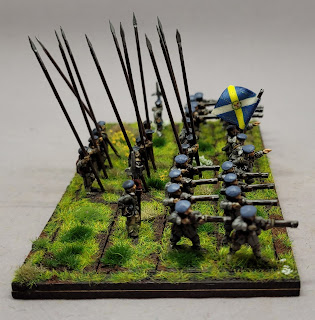Battle of Stow-On-The-Wold, 21st March 1646
Sir Jacob Astley left Oxford in December 1645 to rally troops in the midlands to the King's cause; unfortunately, a lack of money and widespread flooding hampered his task.
Early in 1646, Chester fell to Parliament, and Astley found himself at Worcester; the Parliamentarian Colonels Birch and Morgan were manoeuvring their separate forces forcing his route, and Brereton was advancing south from Cheshire closing the door on Astley's escape north. Another Parliamentarian force, under Fleetwood, was waiting near Stow blocking Astley's road to Oxford.
Somehow Astley managed to outmanoeuvre Morgan and cross the Avon. Morgan would harry Astley's rear-guard delaying his progress, giving time for Birch and Brereton to catch up. Astley was able to make it to the fields north of Stow, where he would make a stand.
Unfortunately for Astley, all three Parliamentarian forces would converge on this position and the Royalists would put up a valiant fight before being routed down into Stow.
But where was the battlefield? Historic England place it 2.6km from the town, where there is a battlefield marker on Donnington ridge, but it is argued that this location is totally unsuitable to deploy the numbers of men involved. Nor have there been any archaeological finds supporting this site. This location is supported by a number of almost contemporaneous secondary sources (later C17 and early C18).
Unfortunately contemporary witnesses aren't too helpful:
a ffield near Stowe
Col John Birch account
A number of other sites have been suggested including the land around the large Tesco superstore (about 0.75km into the town). There have been a small number of metal detecting finds on the north east corner of this site.
A more suitable site, is approximately 1km north of Stow roughly in the region of Greenfield Farm on the A424. A large number of metal detecting finds suggest that this is where the two armies initially faced one another, the spread of finds continuing all the way into Stow (fitting the narrative of a running battle). Whilst not definitive, the number and type of finds are strongly suggestive that this is the most likely location. Further archaeological investigations are planned in order to find further evidence to confirm (or discount) this site.
This work, and reappraisal of the battlefield location was undertaken by Simon March and Sam Wilson (Battlefields Trust and Battlefield Archaeology), who presented their findings at the recent Helion Century of the Soldier conference.
Astley's men would fight their way down into Stow where many of them would be slaughtered. Astley surrendering at the market cross, with his famous words effectively ending the First Civil War:
You have done your work, boys, and may go play, unless you will fall out among yourselves
What's There Now?
The battlefield marker is located in fields north west of Donnington on Donnington Ridge (OS grid SP187 281); follow the footpath heading west located next to the village's Jubilee pump (OS SP192 282). Walking time a slow 10 minutes. Parking is difficult in Donnington to say the least, I found space for just one car at the junction of Donnington Lane and the unnamed lane that forms a square of the village (see map below).
 |
| Looking towards Greenfield Farm |
Stow itself has several visible links to the battle. Parking is difficult in the village at the best of times. There is a large free car park, Fossway Car Park, adjacent to the Tesco superstore. Cunningly placed for views over this suggested location, toilets and an in-store bakery.
St Edward's Church has a modern memorial to those who died in the battle in its churchyard.
 |
| Digbeth Street |
 |
| Adjacent to the cross is Talbot Ture, which has a connection to Charles II's escape from Worcester |
Located upstairs in St Edward's Hall is The Captain Christie Crawfurd English Civil War Collection, comprising 60 portraits, numerous books and artefacts; the portraits can be viewed online at Art UK. The collection consists of a small number of original portraits, and a large number of copies of famous portraits. The collection is currently open by appointment only (use the contact form at the link above). A guide to the collection is available to purchase for £10 (cash only), proceeds going to the upkeep of the collection. Alas no photography is permitted. Many thanks to Tim for his informative interpretation of the collection, and mini tour of Stow. His enthusiasm for the collection shines through. (He'll even escort you to the cash point 😉).
There are also a few items of arms and armour on display in the entrance lobby to the library, some of them dating from the Civil Wars.
Postcodes for SatNavs
Wren House (parking closest to battlefield marker) GL56 0XZMarket Cross GL54 1JW
St Edwards Church GL54 1AE
St Edwards Hall GL54 1AF
Digbeth Street GL54 1BN
.JPG)



.JPG)
.JPG)
.JPG)
.JPG)













Comments
Post a Comment